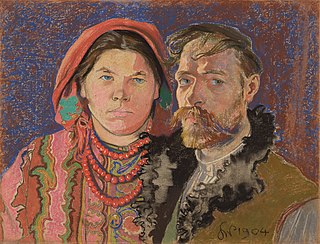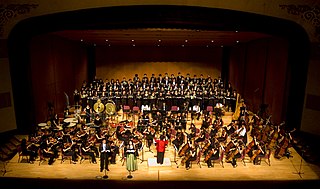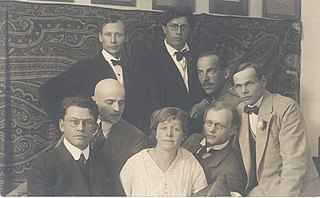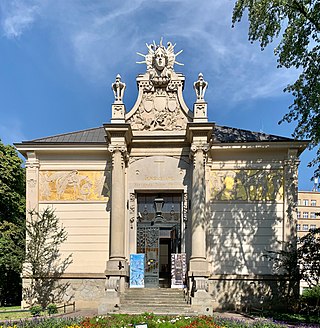 W
WThe term neo-romanticism is used to cover a variety of movements in philosophy, literature, music, painting, and architecture, as well as social movements, that exist after and incorporate elements from the era of Romanticism.
 W
WChłopomania or Khlopomanstvo are historical and literary terms inspired by the Young Poland modernist movement and the Ukrainian Hromady. The expressions refer to the intelligentsia's fascination with, and interest in, the peasantry in late-19th-century Galicia and right-bank Ukraine.
 W
WTyzen Hsiao was a Taiwanese composer of the neo-Romantic school. Many of his vocal works set poems written in Taiwanese Hokkien, the mother tongue of the majority of the island's residents at the time. His compositions stand as a musical manifestation of the Taiwanese literature movement that revitalized the island's literary and performing arts in the 1970s and 1980s. Hsiao's career in music included additional success as a pianist and conductor.
 W
WAleksandar Đokić was a Serbian architect who gained fame for his original designs created in the Brutalist and postmodernist styles. He graduated from the University of Belgrade Faculty of Architecture.
 W
WThe New Romantic movement was a pop culture movement that originated in the United Kingdom in the late 1970s. The movement emerged from the nightclub scene in London and Birmingham at venues such as Billy's and The Blitz. The New Romantic movement was characterised by flamboyant, eccentric fashion inspired by fashion boutiques such as Kahn and Bell in Birmingham and PX in London. Early adherents of the movement were often referred to by the press by such names as Blitz Kids, New Dandies and Romantic Rebels.
 W
WRadu D. Rosetti or Rossetti was a Romanian poet, playwright, and short story writer, also distinguished as an attorney and activist. The son of playwright-aristocrat Dimitrie Rosetti-Max and nephew of Titu Maiorescu, he had a troubled and rebellious youth, but kept company with senior literary figures such as Ion Luca Caragiale. Graduating from the University of Bucharest at age 26, he was already a successful poet of neoromantic sensibilities, a published translator of plays and novels, and also famous for his unhappy marriage to the literary critic Elena Bacaloglu. He then switched to writing social-themed plays and stories of his professional life, earning a high profile as a defender of left-wing causes. From ca. 1913, Rosetti was also the public face of cremation activism, engaged in public polemics with the Romanian Orthodox Church.
 W
WSămănătorul or Semănătorul was a literary and political magazine published in Romania between 1901 and 1910. Founded by poets Alexandru Vlahuță and George Coșbuc, it is primarily remembered as a tribune for early 20th century traditionalism, neoromanticism and ethnic nationalism. The magazine's ideology, commonly known as Sămănătorism or Semănătorism, was articulated after 1905, when historian and literary theorist Nicolae Iorga became editor in chief. While its populism, critique of capitalism and emphasis on peasant society separated it from other conservative groups, Sămănătorul shared views with its main conservative predecessor, the Junimea society, particularly in expressing reserve toward Westernization. In parallel, its right-wing agenda made it stand in contrast to the Poporanists, a Romanian populist faction whose socialist-inspired ideology also opposed rapid urbanization, but there was a significant overlap in membership between the two groups. Sămănătorul's relationship with the dominant National Liberal Party was equally ambiguous, ranging from an alliance between Sămănătorul and National Liberal politician Spiru Haret to Iorga's explicit condemnation of 20th century Romanian liberalism.
 W
WThe Siuru literary movement, named after a fire-bird in Finnic mythology, was founded in 1917 in Estonia. It was an expressionistic and neo-romantic movement that ran counter to the Young Estonia formalist tradition.
 W
Wjohan geeraard adriaan T'Hooft was a Flemish Belgian neo-romantic poet. He is well known for his hippie/junkie lifestyle, death-related poetry and early death at age 21 from a drug-related suicide. These elements have made him a legend in his native country. His life and death by overdose were made into a movie, the English title Junkie's Sorrow.
 W
WYoung Estonia was a neo-romantic literary group established around 1905 and led by the poet Gustav Suits and short story writer Friedebert Tuglas. Other members of the group included Villem Grünthal-Ridala and Johannes Aavik. Gustav Suits articulated the ideology of the group thus:"What buoys up and exalts humanity is education. Our slogan is: More culture! More European culture! Let us remain Estonians, but let us become Europeans too. We want to discover the ideas and forms towards which we are impelled by our national spirit, character, and needs on the one hand, and by European culture on the other."
 W
WYoung Poland was a modernist period in Polish visual arts, literature and music, covering roughly the years between 1890 and 1918. It was a result of strong aesthetic opposition to the earlier ideas of Positivism that followed the suppression of the 1863 January Uprising in the Russian Partition against the occupying Imperial Russian Army. Young Poland promoted trends of decadence, neo-romanticism, symbolism, impressionism and art nouveau.